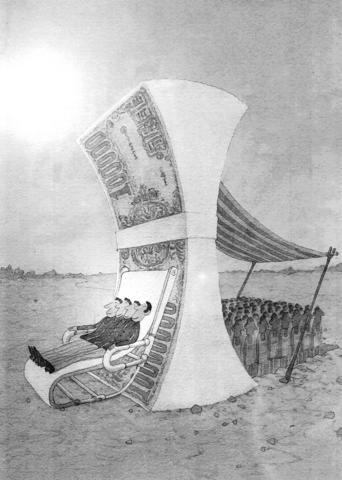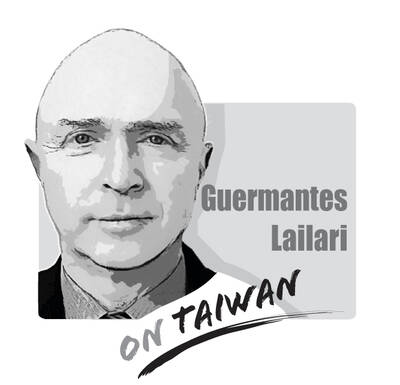Labor disputes in southern China's booming Guangdong Province are becoming increasingly prominent as an unprecedented army of 30 million migrant workers clamors for better conditions and treatment.
This astonishing influx of cheap labor has been the engine of China's capitalist miracle, officials say, making Guangdong the nation's most prosperous region.

ILLUSTRATION: YUSHA
It has also turned the Pearl River Delta into an export-oriented manufacturing hub, from Hong Kong in the east to Foshan in the west.
But as the government tries to maintain the image of an investor's paradise based on low production costs, the workers, increasingly backed by state media, labor rights groups and even the courts, are clamoring for an end to slave-like working conditions.
"There are several causes of worker disputes, but the leading reason is when enterprises don't pay salaries," said Wang Guanyu, director of the Guangdong Labor and Employment Service and Administrative Center. "The workers are very aware of their need to protect themselves so if there are violations, they will complain directly about it."
Another cause is the sweatshop conditions at many factories, including low pay, seven-day work weeks, 15-hour working days, mandatory overtime, a poor working environment and often coercive factory regulations.
Recent riots at the Taiwanese-invested Stella International shoe factory in Dongguan and a spate of other smaller workers' strikes and walkouts in the region reflect the growing sense of labor strife.
"There is not a factory in Dongguan that abides by the Labor Law. I would say 50 to 60 percent of the factories here make you work seven days a week," said a worker surnamed Wu who toils at the city's Henghui packaging factory.
The Labor Law mandates a 40-hour, five-day work week and a range of worker benefits.
Rush of Migrants
Wang said the government's hands were too full trying to administer the migrant rush into Guangdong -- with numbers jumping from 5 million registered workers in 1995 to 10 million in 2001 and nearly 20 million last year -- to concentrate solely on labor issues.
Only registered workers who have had jobs for at least six months are included in the figures, with another 10 million unregistered workers also estimated to have met the six-month working criteria.
A further 10 million could be looking for work, Wang said.
This gives Guangdong by far the largest share of China's officially estimated 140 million migrant workers. Another around 6 million are in Shanghai and 5 million in Beijing.
Most of the workers in Guangdong are under 35, more than half are women and they largely come from impoverished inland provinces like Hunan, Hubei, Jiangxi, Anhui, Guangxi and Guizhou.
Many are engaged in light industrial manufacturing, including electronics, as well as cheap Chinese textiles like plastics, shoes, clothes, toys and furniture that are mainstays in markets worldwide.
`Market Forces'
The government's priority is creating more jobs by attracting investment and building more factories, and the implementation of legally mandated labor rights and benefits should be brought about with "market forces," Wang said.
"Generally speaking, we want to raise the quality and effectiveness of our labor force and this will mean higher wages and better benefits, but this is a process that will take time," Wang said.
"Right now we are hoping to allow the market to work for itself. If factories want a stable work force and don't want to see their trained workers leaving for other factories, then they are going to have to pay them better and give them better benefits."
Besides, it is nearly impossible to monitor work conditions at the tens of thousands of factories that have mushroomed in the region over the past 20 years, he said, admitting that labor laws and regulations were hard to enforce.
Reports last month by China's only legal trade union, the government-run All China Federation of Trade Unions, and the Communist Party-administered Jiusan research group showed migrants made up 35 percent of Guangdong's work force and were responsible for 25 percent of its GDP last year.
However, in the past 12 years their salaries have only risen 68 yuan (US$8) on average, said the reports, cited by the Yangcheng Evening News.
Salaries
Three-quarters of migrant workers in Guangdong made less than 1,000 yuan a month, with most of the rest earning less. Average monthly costs totalled 500 yuan.
By comparison, the average monthly salary for a non-migrant worker in Guangdong was 1,675 yuan.
Despite regulations that call on factories to give all workers retirement insurance, only half of migrant workers had any, the reports said.
Such conditions have resulted in large numbers of migrant workers frequently changing jobs.
Wang insisted that while conditions were difficult, "there are a lot of benefits too."
"Migrant workers in Guangdong made some 30 billion yuan last year, that is about an average of 8,000 yuan a year per worker. Much of that money goes back to their poor rural hometowns," he said.

“History does not repeat itself, but it rhymes” (attributed to Mark Twain). The USSR was the international bully during the Cold War as it sought to make the world safe for Soviet-style Communism. China is now the global bully as it applies economic power and invests in Mao’s (毛澤東) magic weapons (the People’s Liberation Army [PLA], the United Front Work Department, and the Chinese Communist Party [CCP]) to achieve world domination. Freedom-loving countries must respond to the People’s Republic of China (PRC), especially in the Indo-Pacific (IP), as resolutely as they did against the USSR. In 1954, the US and its allies
A response to my article (“Invite ‘will-bes,’ not has-beens,” Aug. 12, page 8) mischaracterizes my arguments, as well as a speech by former British prime minister Boris Johnson at the Ketagalan Forum in Taipei early last month. Tseng Yueh-ying (曾月英) in the response (“A misreading of Johnson’s speech,” Aug. 24, page 8) does not dispute that Johnson referred repeatedly to Taiwan as “a segment of the Chinese population,” but asserts that the phrase challenged Beijing by questioning whether parts of “the Chinese population” could be “differently Chinese.” This is essentially a confirmation of Beijing’s “one country, two systems” formulation, which says that
On Monday last week, American Institute in Taiwan (AIT) Director Raymond Greene met with Chinese Nationalist Party (KMT) lawmakers to discuss Taiwan-US defense cooperation, on the heels of a separate meeting the previous week with Minister of National Defense Minister Wellington Koo (顧立雄). Departing from the usual convention of not advertising interactions with senior national security officials, the AIT posted photos of both meetings on Facebook, seemingly putting the ruling and opposition parties on public notice to obtain bipartisan support for Taiwan’s defense budget and other initiatives. Over the past year, increasing Taiwan’s defense budget has been a sore spot
Media said that several pan-blue figures — among them former Chinese Nationalist Party (KMT) chairwoman Hung Hsiu-chu (洪秀柱), former KMT legislator Lee De-wei (李德維), former KMT Central Committee member Vincent Hsu (徐正文), New Party Chairman Wu Cheng-tien (吳成典), former New Party legislator Chou chuan (周荃) and New Party Deputy Secretary-General You Chih-pin (游智彬) — yesterday attended the Chinese Communist Party’s (CCP) military parade commemorating the 80th anniversary of the end of World War II. China’s Xinhua news agency reported that foreign leaders were present alongside Chinese President Xi Jinping (習近平), such as Russian President Vladimir Putin, North Korean leader Kim